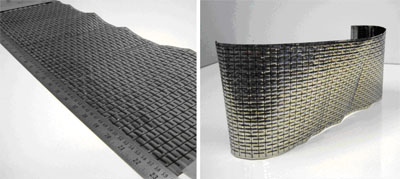|
Thin film deposition and laser patterning for high volume manufacture of
electrical structures
S. Duby, B. Ramsey
The aim of this research project has been to lay the foundation for the
development of a generic, low-cost, high-volume, reel-to-reel process for
the manufacture of functional electrical thin film structures. There are
an increasing number of applications for an effective low-cost integrated
production system for patterned conductive thin films, including RFID, large
area displays and flexible electrical interconnect. This study however has
focused on the manufacture of low-cost thermoelectric devices.
A novel three-step production technique has been developed that allows the manufacture of
complete bi-material thermocouple arrays or thermoclusters. This means that entire devices can be
manufactured using one reel-to-reel, non-stop processing envelope on a single piece of deposition equipment. This process
negates the need for costly and time consuming pattern registration and
involves no sacrificial process agents, both of which have been obstacles
previously preventing low-cost, high-volume manufacture of these
multi-material devices.
 Figure 1: Bimetal thermocluster sheets produced by vacuum deposition and laser patterning.
Figure 1: Bimetal thermocluster sheets produced by vacuum deposition and laser patterning.
The current climate of increasingly stringent legislation on environmental issues, represented by
directives such as WEEE and RoHS implies a sharpening focus on environmental
manufacturing techniques. This process could very conceivably provide a
significant competitive advantage in terms of compliance with this
legislation. There are good prospects that this approach could also
complement other disruptive technologies such as carbon based electronics,
identified as areas of focus in the recent EIGT report.
Applications of thermocluster arrays are wide and varied and include
infrared imaging, process monitoring, airflow measurement for meteorological
application or to aid the design of turbine blades or wing sections and the
provision of power for autonomous microsystems or medical implants. It is
anticipated that a successful low-cost thermoelectric power generation
system could find application in sectors as diverse as the electricity
generation industry in which large amounts of ‘low-grade’ heat is vented
using cooling towers, to the automotive industry, which has already
identified the benefits of capturing otherwise wasted engine heat. Much
interest has already been expressed in the application of this technology to
the capture of solar energy, either by augmenting
the output from photovoltaic cells or to generate electrical power from the
sun directly. This has particular relevance in a developing world context. One of the project collaborators is actively
involved in this aspect of the research and a number of possible
applications have been investigated including the accretion of minerals from
seawater for the production of artificial coral reefs and the manufacture of
carbon-positive building materials.
This work has been a joint collaboration with the Laser Group at Hull University, and
has been supported generously by Teer Coatings Ltd.
|
